Stp31 Courseulles

Information
Stp31 Courseulles
Details
The small port of Courseulles-sur-Mer is on both sides of the river Seulles. There are three defences in the StP Gruppe Courseulles, Wn29, Wn30 and StP31. Here we cover StP31.

The mounting of a dome.

There were two domes like this one on the beach.
Google
Information
Stp31 Courseulles
Details
Stp31 Courseulles

1944
Information
Stp31 Courseulles
Details
This model was captured by the Canadians at the Marie in the centre of the town. It was used as a training aid for the troops stationed in the area. Models have always been used by military people, they allow you to understand an area far better than photos. Every bunker and building would be here so that the new soldiers arriving could be shown what is around their particular area. A lot if the German Infantry could not even speak German, so this would have been used by the Officers and NCO's to explain their duties.
On some of the large ships bringing the Allied infantry across, they actually carried models for the landing troops to look at and get used to the area they were attacking.
Stp31 Courseulles

00-00-00
Information
Stp31 Courseulles
Details
Mike Beach.
An Allied air photo on D-Day, all the black Ants on the beach are tanks trying to get off the beach. The beach by then had been captured but the exits had not been cleared properly.
The red circle is StP31's area.
Stp31 Courseulles

Plan
Information
Stp31 Courseulles
Details
6./736 Inf. Reg., 719 Inf. Div. in command was Hauptmann Grote.
1 x R612 Casemate.
1 x R623 Casemate 10P7 plate.
1 x R666 Observation bunker + dome 749P3.
1 x Vf PC6./736 Rgt HQ.
2 x
Nr1669 ringstands.
1 x U Tobruk FT17 PzT(f).
2 x Vf69 Mortar Tobruk.
2 x Vf58c Tobruk's.
5 x Ic116 Tobruk's.
2 x B206 mortar Tobruks.
2 x 5cm Ringstands.
3 x Vf bunker shelter.
2 x Bf61a mortar Tobruks.
1 x SK/Doppelschartenstand.
2 x 5cm KwK L/60 guns.
2 x 7.5cm F.K.16 n. Art. Field Cannon.
2 x 5cm Gr.W(f) Mortars.
2 x 8.4cm Gr.W.278(f) mortar.

7.5cm F.K.16n.Art. Gun.

5cm KwK L/60 gun.

8.14cm mortar GrW 34(f).
Stp31 Courseulles

DEFE 2/430
Information
Stp31 Courseulles
Details
Hauptmann Grote was in command here. He was not at all happy with the way the bunkers and inland artillery were laid out. He tried to argue his point, but to no avail as the senior Officers thought differently. Commanders in this area, were convinced the attack was to be in the Calais area, when it came it should have been on a high tide. So when a low tide was expected the High Command instantly presumed that Calais was the target.
Was Hauptmann Grote right all along.

Field artillery inland covering the beach.

Shells attached to large posts to explode when they hit a landing ship coming in.

Rommel’s Asparagus
Stp31 Courseulles


09 March 2013 ------------------------------------------------------- Plan
Information
Stp31 Courseulles
Details
Looking west of the defence of StP31 along Mike and Love beeches to the west where there was only basic beach defences of large mine fields and barbed wire. The inland was marshy and criss crossed with ditches. So these were blocked up and the area flooded.
Plan of StP31 and to its right Wn29.

Plan.

Laying mines.

Assembling beach defences.

Barbed wire.
Stp31 Courseulles

DEFE 2/430
Information
Stp31 Courseulles
Details
Combined Operation photo saying its a dummy minefield, I hope it is. Mine fields were usually marked this way with a painted wooden sign, some times in French as well. It is said that there were two colours of sign, one colour meant it WAS a minefield and the other colour that it was a dummy.

Sailor in Combined Operations.
Stp31 Courseulles


Geoportail 1947 ------------------------------------------------------ 10 March 2013
Information
Stp31 Courseulles
Details
Yellow - 5cm KwK
Red - MG.34
We start here on the left flank the track, there seems to be no bunkers or defences on the left of the track. Mine fields (or as we have seen dummy mine fields) laid along the coast to the next defence and plenty of barbed wire. Surprisingly this defence although a very important one only had a machine gun bunker and a field gun bunker facing west with a 5cm Ringstand. Not the heavy fire power of an 8.8cm A/T gun. Perhaps it was the last place they thought the allies would try and land.
Looking east with the tide as it would have been on D-Day morning.

Plan.

MG.34 components.
Stp31 Courseulles
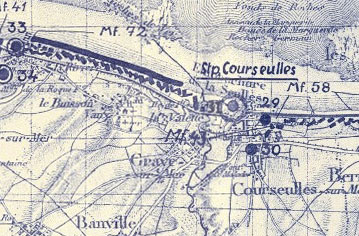
21 March 2015
Information
Stp31 Courseulles
Details
K.V.Gruppe Caen, StP Courseulles, StP31 Courseulles, circled with the dot in it.
Mine Field 72 between Wn33 & StP31, M.F.43 covering the railway on Wn29, M.F.58 covering the eastern side of StP Courseulles.
Wn - Widerstandsnest Self contained unit of infantry positions in 'shell-proof' positions, normally including machine guns and other infantry weapons.
StP - Stützgpunkt
Strong point, usually including heavy and light fortifications with heavy and light Infantry weapons and often artillery.
StP Gruppe Group of strong points.

Defenders the 6./736.
Stp31 Courseulles

21 March 2015
Information
Stp31 Courseulles
Details
Memorial dedicated to the D-Day landings, erected by a grateful French nation.
Stp31 Courseulles

21 March 2015
Information
Stp31 Courseulles
Details
Croix de Lorraine
Cross measuring over 18 metres in height, erected facing the seafront in commemoration of General de Gaulle's return to French soil on the 14th of June 1944.

General de Gaulle's arrival in France.

General de Gaulle.

How the beach would have looked before D-Day.
Stp31 Courseulles

SHM
Information
Stp31 Courseulles
Details
R623 + R612 casemates
A post war photo of the defences facing west along the beach, also the concrete laid after D-Day for the thousands of tanks, lorries and other vehicles that passed over the beach. Where we will see later the Fascine tank that was concreted over at the time to help fill in the anti-tank ditch..

Anti-tank ditch..

Churchill Fascine tank.

How the beach would have looked before D-Day.
Stp31 Courseulles

21 March 2015
Information
Stp31 Courseulles
Details
R623 machine gun casemate with armoured plating.

From above.
Yellow - defence Tobruk.
Red - Periscope.

Plan.

Gunner
Stp31 Courseulles

Geoportail 1947
Information
Stp31 Courseulles
Details
Here stands an R623 machine gun casemate with armoured plating. Plus what looks like an earlier Nr1694 Ringstand for a 5cm KwK L/60 anti tank gun. There is also a large opening Tobruk behind the casemate that may have held an sMG.34.
The casemate facing left with a flanking wall covering the embrasures sea ward side, a small spotting Tobruk in its roof for close defence, ant-air or just watching/spotting for the gun below. Also there is a periscope for the guns commander to use, also aid spotting for the gun.
Being a machine gun bunker seems very odd, another harder hitting weapon seems to have been needed. So an Nr1694 Ringstand may have been added (or was already here) for a 5cm KwK gun. The gun originally designed for the Panzerkampfwagen III tank, was being replaced in the tank with a much better 7.5cm guns. And this model found a new lease of life all along the Atlantikwall, as an anti-landing craft, anti-tank gun. On D-Day they did great service, knocking out many tanks & landing craft, either until their ammunition ran out or they were captured/destroyed. Here originally was an L/42 but later up-graded to an L/60.

R623 machine gun casemate with armoured plating.

455P01 steel plate inside a bunker.

Observation.
Stp31 Courseulles

Internet
Information
Stp31 Courseulles
Details
5cm KwK L/42 earlier model without a shield fitted, but gives an idea of what this Ringstand would have looked like. Here a crew of four, commander, gunner, loader and ammunition carrier. There would have been spare ammunition in niches around the concrete base of the emplacement. This gun was replaced by an L/60 up rated model with a muzzle break, giving the shell far better hitting power.

Ammunition.

An L/60 model.

Nr1694 Ringstand and ammunition niches.
Stp31 Courseulles

DEFE 2/433
Information
Stp31 Courseulles
Details
5cm KwK L/60
This is the gun in its position after D-Day.
The gun may have been put out of action by fire from the sea, but it was reported that the gun fired, so that it probably was in serviceable condition after the fire from the sea finished. The gun shield was badly broken, probably by close range fire from a tank.
(DEFE 2/433 report).

L/42.

L/60.
Stp31 Courseulles

Internet
Information
Stp31 Courseulles
Details
R623 casemate
Looking at the plan, first there was a gun room behind the heavy metal 10P7, Pz.-Schartenplatte. Then a small ammunition room. The main crew room for at least four or more men. Then the gas lock doors closing the bunker off from outside and the close combat defence room with a machine gun covering the rear entrance. On the left hand front top, is a defence Tobruk. A periscope for all around vision.

R623 casemate, red the 10P7 steel plate.

R630 gun room.
.

R630 ammunition room.

R630 crew room to ammunition room.

R630 crew room with door to gas lock and way out..
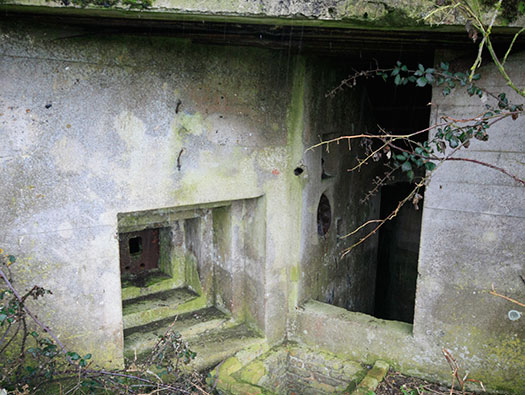
R630 rear entrance and close combat defence embrasure at the left side.
All these small pictures are from an R630 at Die10 Mont Robin, Dieppe. A 630 & 623's are very similar.
Stp31 Courseulles

MKB Bunkertour
Information
Stp31 Courseulles
Details
MKB's model of an R623 casemate.
It shows the metal plate in the front & at the side, the first door for the defence Tobruk, the second door is the entrance to the bunker and then the close combat embrasure for a machine gun to cover the back door. The entrance would be closed off with a Gittertür gate. If an intruder wanted to throw a grenade or try to enter, there is another close combat embrasure down the stairs probably with a sub machine gun covering it if necessary.

Ammunition.

491P2 Gittertür steel gate.

MP38 sub machine gun.
Stp31 Courseulles

21 March 2015
Information
Stp31 Courseulles
Details
R623 casemate
Looking into what would have been the embrasure and its front metal plate. The plate was held in place by six long metal bolts and then the concrete was finished covering most of the plate. There would be around four/five men running this bunker, commander, gunner, ammunition handler, Tobruk observation/defence gunner and a spare man to wined the extractor fan and cover the rear door.
When the gun is firing, toxic fumes are given off by the gun, these would be vented outside via a specially made anti-gas pump that would pump fresh air in through a filter for smoke & fumes, or an anti-gas filter for filtering out gases that an enemy may be used to neutralise the crew. Gas was never used but still had to be defended from it.
.jpg)
10P7, Pz.-Schartenplatte. for an MG.34.

10P7, Pz.-Schartenplatte. for an MG.34 plan.

Machine gunner in place about to fire his gun.
Stp31 Courseulles

21 March 2015
Information
Stp31 Courseulles
Details
R623 casemate
The top of the casemate, very little can be seen as it is now covered in sand. The Tobruk defence shows up well and you can see the steel armoured ring of the periscope fitting.
A gas proof, new type strong point fitted with air conditioning pumps and a periscope. Sleeping accommodation was for 9 men, and 20 were reported to have surrendered. A heavy machine gun could
cover the beach to the west, firing through a small 12" by 9" in a 2" thick steel shield. A 3' diam Tobruk type MG post was fitted flush with the roof, with access from outside the main shelter. The main entrance to the shelter was on the shore side, and connected by trench systems to other posts. The roof of the shelter was level with the top of the dunes at the back of the beach.
DEFE 2/433 report.

Defence Tobruk.

Steel armoured ring 735P3 type for the periscope.

Periscope inside a bunker.
Stp31 Courseulles

21 March 2015
Information
Stp31 Courseulles
Details
R623 casemate
This is the view the gun would have had, its job was to fire down the beach with fixed lines of sight. Not normally a spraying action but an intermittent straight line fire. Buuurp, Buuurp, Buuurp.

Gunner

Commander.

Gunner.
Stp31 Courseulles

21 March 2015
Information
Stp31 Courseulles
Details
The British managed to design a swimming tank, but that was an old model and could not be used against the Atlantikwall. But the Americans came along with the M4A4 Sherman tank. Now this tank was excellent, it completely lent itself to a swimming tank design. By removing the rear bogies and adding two drive wheels, and to these added two, what look like outboard motors driven by the tracks and rear bogies. Then seal all the hull up to make it watertight and build a heavy flotation skirt all the way around the sides that could be raised and locked open. Exhaust and air vents were passed through long tubes. On arrival at the beach, the turning tracks driving the two propellers would start to bight on the sand and then drive up the beach, dropping the flotation shield and then bringing the gun into action. On the day it was a very successful floating tank. They went on to be used in Holland and in the crossing of the Rhine.

Leo Gariepy.

DD Sherman Tank.

Swimming in.

Working their way along the beach..

The DD Sherman sitting in the centre of Courseulles today..

The motors drive wheel, the gearbox allowing the energy to be transmigrated through 90° to a propeller. Both propellers were driven by their individual tracks so to turn you just drove the tank as you would on land.
Stp31 Courseulles

21 March 2015
Information
Stp31 Courseulles
Ic116 type Ringstand
Details
This may have had a heavy machine gun..

Tobruk 1964 air photo.

Ic116 type Ringstand. (PC).
Stp31 Courseulles

09 March 2013
Information
Stp31 Courseulles
Details
The beach in front of the defence would have seen all sorts of Rommel´s asparagus. Named that, as they started to sprout along the coast like Asparagus shoots..
Stp31 Courseulles

Geoportail 1947
Information
Stp31 Courseulles
Details
The second part
Covering the area above the roadway. Red are the two 7.5cm Field Guns and the yellow are the machine guns.

Plan.

Vf58c Tobruk..

Ic116.

R612 casemate.
Stp31 Courseulles

Geoportail 1947
Information
Stp31 Courseulles
Details
Vf58c Tobruk.
Showing up here is a lip along the rear side of these 58c Tobruks and that is to keep back earth thrown up onto the roof as camouflage and also to stop rain water dripping into the door.

Vf58c Tobruk.

The lip runs along the top of the door.
Stp31 Courseulles

Geoportail 1947
Information
Stp31 Courseulles
Details
Ic116 type has a larger opening and a small crew room behind and also used as an ammunition store. There would be spare ammunition for either the machine gun or mortar which ever was used here. Then hand grenades, rifle ammunition, food and personnel kit.

Ic116.
Stp31 Courseulles


DEFE 2/433 ------------------------------------------------------------- via SD
Information
Stp31 Courseulles
Details
R612 casemate
This casemate was for a 7.5cm F.K.16 n.Art. Field Kannon. An old horse drawn type of WW1 vintage.
Showing off its battle damage.

7.5cm F.K.16 n.Art.

Ammunition.

Ammunition.
Stp31 Courseulles


21 March 2015 --------------------------------------------------------- via SD
Information
Stp31 Courseulles
Details
R612 casemate
The open embrasure, not that large but it does allow a field gun to track left and right.

details

Wooden doors fitted to some casemates.

Schwere Holztur 620x760mm.
Stp31 Courseulles

21 March 2015
Information
Stp31 Courseulles
Details
R612 casemate
The D-Day fighting here was extremely difficult, the Canadian infantry took a high toll due to such a well defended area.

Landing D-Day.

Canadian Army Officers.
Stp31 Courseulles

21 March 2015
Information
Stp31 Courseulles
Details
R612 casemate
Gun room where crew and gun would have sat pointing this way.

How it may have looked.

Crew.
Stp31 Courseulles


09 March 2013 ----------------------------------------------------------- via SD
Information
Stp31 Courseulles
Details
R612 casemate
The very thick flanking wall protecting the embrasure from direct fire from the seaward side. This model has square sides, so it is really a casemate for a town scape. When built with houses around it, it is better camouflages than one with rounded shapes.
Built like the R623 of Formstien.
The gun can be seen moved around and the two direct hits show up well. Also it looks like a crew of a landing craft have come assure for some R&R.

R612 casemate plan.

R612 casemate plan for built up areas.

Feinstein blocks and steel reinforcement. A concrete block that could be built quicker than the wooden shuttering type.

Steel girders.
Stp31 Courseulles

09 March 2013
Information
Stp31 Courseulles
Details
R612 casemate
The sea action has undermined all the casemates along this defence.
You can see the Formstien concrete blocks being used in its construction.
Stp31 Courseulles


09 March 2013 ----------------------------------------------- via SD
Information
Stp31 Courseulles
Details
R612 casemate
Gun room, looks like its sinking. Both sides at the rear are two ready ammunition rooms.
Here it looks like stranded ships crew have taken it over as a billet and making themselves very comfortable.

R612, the two small ammunition rooms each side at the rear,

Some casemates had heavy steel doors, these would have been removed after the war and scrapped.

Ammunition storage.
Stp31 Courseulles

09 March 2013
Information
Stp31 Courseulles
Details
R612 casemate
The broken rear bunker wall.
Stp31 Courseulles


Geoportail 1947
Information
Stp31 Courseulles
Details
R612 casemate
Looking at the casemate from above, with that thick flanking wall and the intact rear wall.
Strong concrete 75mm gun position, with roof of about 7' thick. seaward walls 6-7' thick with sand ramped
up about 10' above ground level.; one gun fired out of a window (embrasure) about 8' by 3' to the westward, with an arc of 20° either side of bearing 315°. A shell probably a 4.7" from seaward direction and shown by part were extra deep penetration had allowed. had made a crater about 11/2' deep, 5' in diam above the gun window, but this may not have put the gun out of action. The gun was hit on the barrel just forward of the breach mechanism by a shell, reported to be from a DD tank but possibly a 4.7"shell which was embedded in the wall inside. Several hits around the window were probably produced by tank fire. The 75mm gun had been fired as empty shell cases were seen, and reports were obtained from people who were present on D-Day. It was reported that several casualties by MG fire were suffered by infantry who tried to assault the position from seaward. The eastern side of the gun emplacement had an entrance through which the gun was wheeled. This entrance was covered in heavy logs. Near the entrance was an open circular gun platform similar to the ones at E Courseulles.
DEFE 2/433 report.
A Canadian Crusader III AA MkI tank with a 40mm Bofors gun mounted.
Redundant as a main battle tank, several chassis were converted to the anti-aircraft role, by adding either a Bofors 40mm or twin Oerlikon 20mm.
Next to the Crusader is a Sherman DD tank. It looks as this is as far as it got.
Stp31 Courseulles

Geoportail 1947
Information
Stp31 Courseulles
Details
The third section
Two interesting bunkers, a water reservoir, a turreted Tobruk.
Each of the bunkers would have been connected by armoured telephone cable to the HQ bunker, they were then connected to their respective upper HQ and also the artillery HQ covering their area. Due to the bombing and shelling. A lot of cables were severed and that meant that communication was down to runners going out delivering messages.

Plan.
Stp31 Courseulles


Geoportail 1947 --------------------------------------------------- DEFE 2/433
Information
Stp31 Courseulles
Details
Tobruk + 89P9 Panzertürm
A Tobruk with an 89P9 Panzertürm and would be used as an observation bunker. It had no offensive weapons, so could not fight. 6cm in thickness (or 2.3622inches) Three small embrasures to look out from. The dome would be set quite low into the concrete.
DEFE 2/433.

89P9 Panzertürm Dieppe.

Plan 89P9.

89P9 Panzertürm
Stp31 Courseulles

Geoportail 1947
Information
Stp31 Courseulles
Details
Ic116
For a heavy machine gun.

Ic116 .
Stp31 Courseulles

SHM
Information
Stp31 Courseulles
Details
Ic116
This could be the Ic116 or a heavy machine gun.

Ic116 .
Stp31 Courseulles


Geoportail 1947 --------------------------------------------------- DEFE 2/433
Information
Stp31 Courseulles
Details
U-Tobruks FT17 PzT(f)
Turret removed from an FT French tank based on a WW1 design. Although redundant and not to modern standards, the Germans actually brought these tanks back into service and used many as lower grade Panzer Regiments to be used in the Atlantikwall and against partisans. Mounted with a French machine gun MG.311(f). Spare turrets were used on U Tobruks like this. The Americans paratroopers were attacked unsuccessfully at La Fiere Bridge, Sante-Mère-Église by several FT tanks.
A small MG post (form of Tobruk 3' diam type) with 1/8" thick steel plate cupola on top. A hit on the cupola had made a hole 1' by 1'; this would have put the position out of action. The cause of the damage was not found.
DEFE 2/433 report.

Maisy port.

U type Tobruk.

FT17 PzT(f) tank turret machine gun.
Stp31 Courseulles

09 March 2013
Information
Stp31 Courseulles
Details
Wasser
Large water reservoir.
Stp31 Courseulles

11 November 2016
Information
Stp31 Courseulles
Details
R666
observation bunker.
Observation turret - plotting room/chart room - entrance and gas lock. Outside a defence Tobruk.
Stp31 Courseulles

Geoportail 1947
Information
Stp31 Courseulles
Details
R666 Infantry observation post with small turret
Trench entrances at the rear, a defence Tobruk and in the front a 486P2 steel dome shining white. Three embrasures to view out and a hole in the top to allow a periscope to be used.

Plan.

486P2 with periscope.
Stp31 Courseulles

11 November 2016
Information
Stp31 Courseulles
Details
R666 bunker
The dome has been cut out from the concrete and scrapped in the 40's.

Periscope observation.

Plotting and planning.

Probably drinking Snaps.
Stp31 Courseulles

MKB Bunkertour
Information
Stp31 Courseulles
Details
R666 bunker. How it looked after capture with the two armoured aerial tubes sticking up and the cupola still in place.

MKB Bunkertour.

749P3 cupola.

Bunker aerials.
Stp31 Courseulles

11 November 2016
Information
Stp31 Courseulles
Details
R666 bunker
Where the dome fitted.

749P3 cupola.
Stp31 Courseulles

12 June 2017
Information
Stp31 Courseulles
Details
R666 bunker
Stp31 Courseulles

MKB Bunkertour
Information
Stp31 Courseulles
Details
R666 bunker
A nice plan of the bunker, thank you Kurt. The dome, plotting room, the escape on the right side. The armoured aerial slots and the exit. Also on the left the Tobruk defence..

MKB Bunkertour.
Stp31 Courseulles

12 June 2017
Information
Stp31 Courseulles
Details
R666 bunker
Rear entrance also made in Formstien concrete block.
Stp31 Courseulles

12 June 2017
Information
Stp31 Courseulles
Details
R666 bunker
Tobruk defence. The small niche is for a speaking tube to connect to the inside of the bunker.
Stp31 Courseulles

12 June 2017
Information
Stp31 Courseulles
Details
R666 bunker
Steps down into the bunker.
Stp31 Courseulles

12 June 2017
Information
Stp31 Courseulles
Details
R666 bunker
The escape on the side.

Escape tunnel inside.

Escape outside.
Stp31 Courseulles

12 June 2017
Information
Stp31 Courseulles
Details
R666 bunker
The escape, you can just see the steel ladder rungs.

Plan of an escape.

Here they used the half round style escape.

Steel ladder.
Stp31 Courseulles

12 June 2017
Information
Stp31 Courseulles
Details
R666 486P2 dome
Where the dome fitted.

Turret.
Stp31 Courseulles

12 June 2017
Information
Stp31 Courseulles
Details
The view today, they were closer to the water as there has been a build up of sand on the beach over the years.
Stp31 Courseulles

12 June 2017
Information
Stp31 Courseulles
Details
R666 bunker
A trench ran out from the bunker and into a covered tunnel to the Vf HQ bunker.
Strong point built into the back of the sand dune about 20yds behind back of beach. This is a equipped with comfortable living quarters, a hemispherical periscope housing, (486P2 dome) and a small (3' diam) Tobruk type MG post. The position was gas proof and of typical heavy construction 7' concrete roof. The top of the roof was flush with the ground level, so that strength in-front was provided by 20yds of sand. The periscope housing was hemispherical. 5' diam externally, and of steel 9" thick. Three periscopes were fitted to look out of small slits 1" by 6" and could be traversed to cover a full 360° between them. The entrance to the MG post was outside the main gas proof shelter, so with similar positions at E Courseulles. The position was completely undamaged.
DEFE 2/433.
Stp31 Courseulles

11 November 2016
Information
Stp31 Courseulles
Details
Vf HQ of the 6./736 Reg.

Plan of the Vf HQ of the 6./736 Reg.
Stp31 Courseulles

12 June 2017
Information
Stp31 Courseulles
Details
Plan.
Stp31 Courseulles

12 June 2017
Information
Stp31 Courseulles
Details
Vf
Steps down into the trench to the tunnel.

Vf.
Stp31 Courseulles
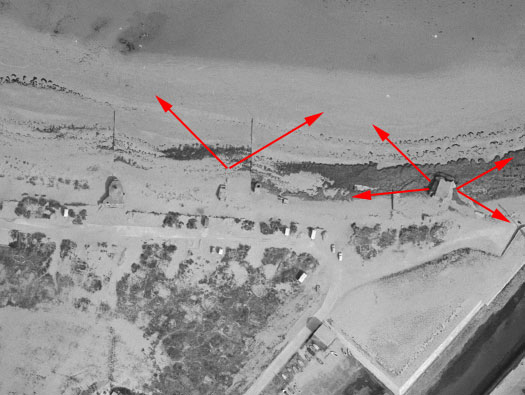
Geoportail 1964
Information
Stp31 Courseulles
Details
Next the East flank of the defence.
R666, Vf bunker, Ringstand, Ic116 another Vf and an SK/Doppelschartenstand.

Plan.

SK/Doppelschartenstand.
Stp31 Courseulles

Geoportail 1964
Information
Stp31 Courseulles
Details
The Nr1694 looks either destroyed or washed away since the 1960's, there was a small observation bunker with a steel plate for a roof and then an Ic116 Tobruk. An MG.34 or an MG.08, WW1 type water cooled machine gun may have been installed in it. These observation smaller bunkers could have been for an artillery unit or even a Luftwaffe aircraft observation unit, early warning/reporting of aircraft coming over.

Vf observation with a steel plate that may have completely covered the roof or just the observation. .

Nr1694 Ringstand for a 5cm KwK.

Ic116.
Stp31 Courseulles
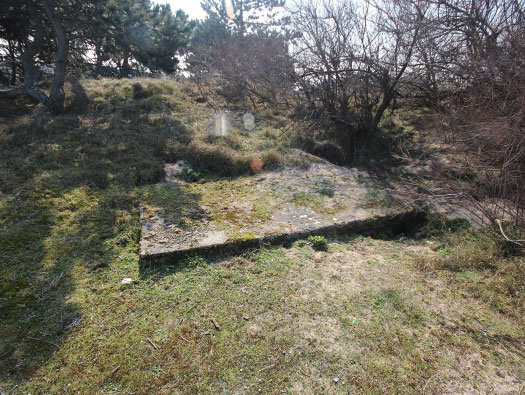
Geoportail 1964
Information
Stp31 Courseulles
Details
Vf bunker hidden in the sand dunes.
Stp31 Courseulles

Geoportail 1964
Information
Stp31 Courseulles
Details
SK/Doppelschartenstand a bunker that can shot out of one embrasure and then if needed to turn 180° and engage targets with the other.

5cm KwK L/60.
Stp31 Courseulles

USAAF reconnaissance flight
Information
Stp31 Courseulles
Details
SK/Doppelschartenstand
This picture was take just after completion, it looks in really good condition but by D-Day the sea had eroded the sand from underneath it and the casemate had started to sink.
Stp31 Courseulles

Information
Stp31 Courseulles
Details
SK/Doppelschartenstand
This picture was taken just post D-Day and you can see here that it has sunk by quite a lot. I have seen a lot of photos and most post war that show this casemate badly listing, but I am not convinced that it was like this on D-Day??
Stp31 Courseulles

12 June 2017
Information
Stp31 Courseulles
Details
SK/Doppelschartenstand
Looking east.
Stp31 Courseulles

Martian Report
Information
Stp31 Courseulles
Details
SK/Doppelschartenstand
Allied plan.
Stp31 Courseulles

21 March 2015
Information
Stp31 Courseulles
Details
SK/Doppelschartenstand entrance.
Stp31 Courseulles

21 March 2015
Information
Stp31 Courseulles
Details
SK/Doppelschartenstand
Looking west.
The concrete emplacement about 33' square (external) with large buttressed corners, housing a 5cm anti-tank gun. The gun was fired through a window (embrasure) 12' by 21/2' facing west along the beach, and had an arc of of about 40°. The concrete roof was 4' thick and the main walls about 5' thick. Buttresses about 8' wide and the corners provided extra strengthening. The reinforcing was 1/2" steel at about 11' spacing. The gun could also fire from similar window (embrasure) eastwards. A shell had knocked off the corner about 3' by 3' if the SW buttress at 'A'. Above the west gun window (embrasure) a shell had made a 5ft diam, 21/2' deep hole. The emplacement was sited on top of the breakwater and this had been hit. A hit on the seaward side of the post had penetrated 11/2'. One hit at 'A' was probably caused by fire from seaward. That at 'B' may have been from the sea, but it is more likely (from the symmetry of the hole) to be a shot from directly in front of the gun window by a tank. There was no hits on the embrasures, except for a few hits on the east side window, and it was reported that the gun was fired until surrounded by infantry.
DEFE report.
Stp31 Courseulles

Martian Report
Information
Stp31 Courseulles
Details
SK/Doppelschartenstand
Allied plan showing that you can shoot both ways, a cheap way of producing two bunkers in one. It would hold a small amount of ready ammunition but for prolonged firing, a second magazine would have been needed..
Stp31 Courseulles

21 March 2015
Information
Stp31 Courseulles
Details
SK/Doppelschartenstand
Entrance.
Stp31 Courseulles

DEFE 2/433
Information
Stp31 Courseulles
Details
SK/Doppelschartenstand
Stp31 Courseulles

Information
Stp31 Courseulles
Details
SK/Doppelschartenstand
Stp31 Courseulles

21 March 2015
Information
Stp31 Courseulles
Details
Now covering the rear of the defence.
Stp31 Courseulles

Geoportail 1947
Information
Stp31 Courseulles
Details
Vf61a mortar Tobruk's
2 x Vf61a mortar Tobruk's for 5cm Fest.Gr.W. mortars. These mortar bombs like their larger 8.14cm, would have been fired off at a fast rate onto the Canadians landing on the other side of the sand dunes. They would have been called and targeted by the two steel domed Tobruk/observation bunkers on the seaward side.

Plan.

Vf61a mortar Tobruk.
Stp31 Courseulles

DEFE 2/433
Information
Stp31 Courseulles
Details
Vf61a mortar Tobruk's
One of the Vf61a mortar Tobruk's for 5cm Fest.Gr.W. mortars photo taken just after D-Day.
Many empty ammunition boxes were in the vicinity.
DEFE 2/433.

Vf61a mortar Tobruk.

5cm Fest.Gr.W. mortars.
Stp31 Courseulles

21 March 2015
Information
Stp31 Courseulles
Details
No idea what this was for, looks more like a plant pot.
Stp31 Courseulles

21 March 2015
Information
Stp31 Courseulles
Details
Ringstand for a 7.5cm F.K. n.Art.
Big open pit for a 75mm gun. There was no trace of gun, and it is probable that this was only a temporary site.
[DEFE 2/433 Report of Special Observer Party investigating the effect of fire support]

Plan.

7.5cm F.K. n.Art.
Stp31 Courseulles
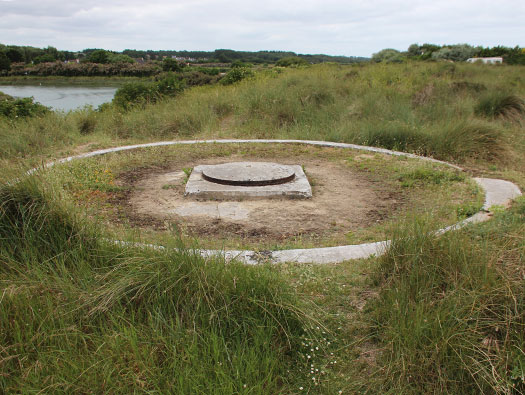
12 June 2017
Information
Stp31 Courseulles
Details
Ringstand for a 7.5cm F.K. n.Art. A very open position and vulnerable for the gunners.
Stp31 Courseulles

21 March 2015
Information
Stp31 Courseulles
Details
Vf69 mortar Tobruk
From here and the one next to it (now either removed or covered over) would have rained down 8.14cm mortar bombs all over the beach area onto the Canadians landing. More men were killed and wounded on D-Day by artillery and mortar bombs than bullets.

Vf69 mortar Tobruk. Main gun room, Tobruk defence/spotting, ammunition room and small space for crew.

8.14cm Gr.W278(f).
Stp31 Courseulles


12 June 2017 ------------------------------------- DEFE 2/433
Information
Stp31 Courseulles
Details
Vf69 mortar Tobruk
The second picture is of the same style of mortar bunker but was situated where the large petrol station is now situated in Berniers-ser-Mer.

Vf69 mortar Tobruk.

Two mortar teams.
Stp31 Courseulles

09 March 2013
Information
Stp31 Courseulles
Details
Ic116 Tobruk
A heavy machine gun Tobruk or a mortar Tobruk.

08 Machine gun.
Stp31 Courseulles


09 March 2013
Information
Stp31 Courseulles
Details
Ic116 Tobruk
In the second picture you can see the centre spigot for a plate to sit on and take a machine gun or mortar.
Stp31 Courseulles


SHM ------------------------------------------DEFE 2/433
Information
Stp31 Courseulles
Details
Ic116 Tobruk
This position could not fire on the seaward side at all but would have covered the road bridge at the distance.
How it may have looked inside. This one was actual to the east side of Courseulles.
Stp31 Courseulles

09 March 2013
Information
Stp31 Courseulles
Details
A small bunker Vf of some sort.
On the beaches of Arromanches and Graye / Courseulles, at the end of July 1944, 16,000 soldiers and 400 tanks of the 1st Polish Armoured Division landed with General Stinistaw MACZEK at their head.
"For our and your freedom"
Na plaéach Arromanches i Graye / Courseulles, pod koniec lipca 1944, wyladowato 16000 Éotnierzy i 400 czotgfew, Polskiej 1. Dywizji Pancernej na czele z generatem StanistawemMACZKIEM
"Za wolnoit nasza i mus.,"

Polish Armour.
Stp31 Courseulles

12 June 2017
Information
Stp31 Courseulles
Details
Graye sur Mer, AVRE Churchill Fascine carrier.
Graye-sur-Mer was in Mike sector of Juno beach. Defences on this sector were formidable with an extensive amount of barbed wire and mines. The proposed exit from the beach ran through marshy ground which had been flooded by damming the stream which flowed through it. The exit road crossed the stream at a small culvert which had been heavily cratered forming a 63ft gap. A large tank trap, 16 ft wide and 9 ft deep, had been dug in the centre of the exit. When the 26th Assault Squadron touched down, DD tanks (swimming tanks) were first on the beach together with the assaulting infantry. Their flail tanks started mine clearance operations up to the two exits, the main one and another 900 yards west of Courseulles. The latter soon accounted for one tank, having its track blown off in the mine field. Two others were damaged, blocking the entrance. The remaining tanks therefore concentrated on the main exit. An 8 ft Fascine (bundle of logs) was dropped into the tank trap. Tanks then crossed the gap and worked their way up the main track avoiding waterlogged craters on the way. On the back of the dunes the tanks came under fire from mortars and machine guns from the cross-roads ahead on the main coast road. Not realising the size of the culvert crater Captain Hewitt ordered up a Fascine tank to fill it.

Sherman Flail tank.

Churchill Fascine carrier.

Churchill bridge layer.
Stp31 Courseulles

12 June 2017
Information
Stp31 Courseulles
Details
Churchill Fascine carrier
The driver, George Dunn, eased the tank forward on to what he thought was a patch of weeds as wind blown sand covered the water in the crater. The front of the tank dipped and then he saw water through the weeds and started to slide. He stopped the tracks but the tank fell, the day light through the visor was cut off and the vehicle stopped. Water poured on top of him but somebody pulled him out and laid him on the turret which was only just above the water. The crew of six managed to get out but three were severely wounded by mortar fire before they could reach the cover of the dunes. The surviving three were evacuated to the UK that Afternoon. The SBG bridges carried by the AVRE tanks were only thirty feet long. A bridge was laid to rest on the tank and more fascines dumped into the water ahead. Troops brought up logs from the beach and at 9.15, an hour and a quarter after the troops landed, the first tanks and infantry crossed the bridge and rushed the houses at the cross-roads from which machine guns and mortars had been firing all the time. Six tanks had crossed the bridge when it started to slide off the sunken AVRE. Traffic was then stopped whilst the bridge was secured. Four more tanks got across until a Sherman became bogged. This was towed out and more logs brought up. The driver of the first self-propelled gun to cross the bridge misjudged the distance and bellied himself in such a way that the tracks turned on thin air. Three bulldozers tried to get him off but failed and two AVRE tanks had to be called up. During this time a horse and cart was obtained from a farmer and rubble brought up from ruined houses. Later on the crater and submerged tank were concreted over. Later still the tank was recovered and cosmetically restored and placed alongside the place it had been hidden for so many years. JF.
Stp31 Courseulles

12 June 2017
Information
Stp31 Courseulles
Details
Stp31 Courseulles

11 November 2016
Information
Stp31 Courseulles
Details
 Norway (coming soon!)
Norway (coming soon!)
 France
France
 Great Britain
Great Britain








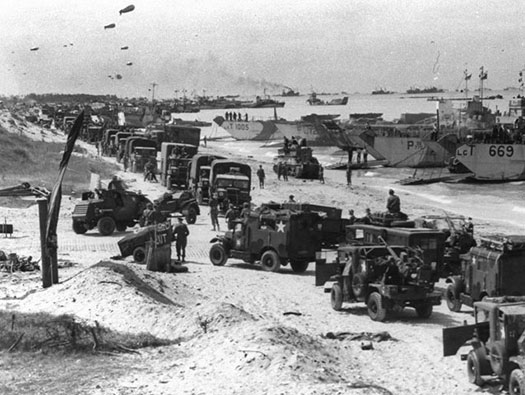
































































.jpg)





















































































































































































